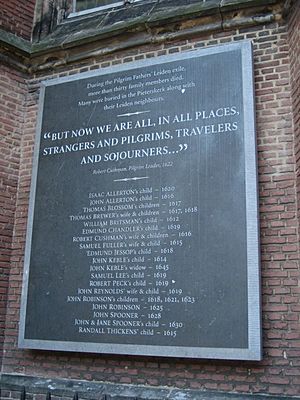Scrooby Congregation facts for kids
The Scrooby Congregation was a group of English Protestants who wanted to worship God in their own way. They were called separatists because they separated from the official Church of England. They lived near a village called Scrooby, close to the town of Bawtry. This area is where South Yorkshire, Lincolnshire, and Nottinghamshire meet. In 1607 and 1608, this group moved to the Netherlands. They went there to find the freedom to practice their religion as they believed was right. In the Netherlands, they started the "English separatist church at Leiden."
A New Way to Worship
Richard Clyfton was a church leader in Babworth. By 1605, people suspected he did not follow the official church rules. Even after being suspended, he kept preaching in Bawtry. This town was near Scrooby, just across the county line in Yorkshire.
From 1606, the group around Clyfton met at the home of William Brewster. His house was on the land where an old palace used to be. In 1607, Clyfton was removed from the church. Around this time, he had already met William Bradford.
John Robinson was another leader from Sturton le Steeple. He also lost his church position because of his beliefs. He returned home around 1604. Robinson then connected with other separatist groups. These included groups in Gainsborough and Scrooby. The minister in Gainsborough was John Smyth. This is how the two separatist churches came together. Robinson became a leader in the Scrooby congregation with Clyfton.
Moving to a New Country
From late 1607 into 1608, the separatist groups from Gainsborough and Scrooby began moving to Holland. They left in different groups over time. Thomas Helwys from Smyth's group helped organize this big move. He had moved to Basford, Nottinghamshire before this. The people who left went to cities like Amsterdam and Leiden.

Life in Leiden
When the Scrooby Congregation arrived in Holland, they faced new challenges. As foreigners, they could only get jobs that did not require special skills. They also noticed that their children were growing up more Dutch than English.
The Congregation wanted their children to keep their English identity. Most importantly, they wanted to worship freely without any problems. Because of these reasons, they decided to move again. This time, they planned to go to the Americas.


